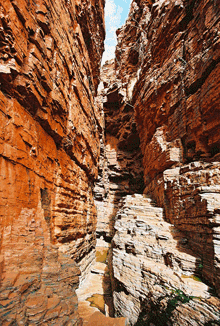![]()

Karijini National Park: one of Australia's most spectacular national parks, Karijini is haunting in its rugged, red beauty. The park is famous for its sheer gorges, waterfalls and cool swimming holes. Located in the heart of the Hamersley Range which dominates the Pilbara Region of WA, Karijini has a system of excellent walk trails of varying levels, for the beginner to the adventurous, which will lead you deep into the subterranean gorges and through waterfalls where you can dive into sparkling rock pools.

![]()
Aboriginal Rock Art: One of the lesser known aspects of the Murchison/Pilbara regions is its wealth of ancient Aboriginal rock art. Walga Rock near Cue is home to the largest gallery of Aboriginal rock paintings in Western Australia, most notably (from a European perspective) a painting of a sailing ship. There has been a great deal of speculation about this painting, especially considering it is located 325 kilometres from the coast. Hundreds of thousands of Aboriginal rock engravings can be found on the Burrup Peninsula in the Dampier Archipelago. They range from small engravings of Emu tracks to very large ones depicting the Tasmanian tiger, whales, kangaroos, emus and thousands of Aboriginal ceremonies. These are just two of hundedes of art sites in the two regions.

![]()
Iron Ore Mine Tour: The main activity in the Pilbara is mining, centred at towns like Tom Price, Paraburdoo and Newman. Today the Pilbara economy is crucial to the State, providing two of the State's largest export revenue earners - iron ore and liquefied natural gas. A number of mines conduct tours which take visitors deep into the workings of what are some of the largest open cut mines in the world.

|
![]()
West Pilbara Coast: Centred around the town of Karratha, the West Pilbara Coast boasts excellent weather, great fishing, spectacular scenery, clear blue waters to swim in, glorious sunsets and the wonder of the spectacular natural phenomenon, Staircase to the Moon. The region is a mix of old and new - ancient Aboriginal rock art and historic towns of Cossack and Roebourne stand alongside iron ore loading facilities where giant ore carriers come and go.

![]()
Mt Augustus: The world's largest monolith, Mt. Augustus is more than twice the size of Uluru, it is almost 8 km long, it stands 858 m above the surrounding plain and 1105 metres above sea level. Mt. Augustus is surrounded by other fascinating geological formations, Aboriginal rock art and engravings plus a wealth of animal and bird life. The journey to Mount Augustus is far from easy (4-wheel drive only) but the result of the effort is a rare opportunity to see one of the wonders of Australia. The most significant difference between Uluru and Mount Augustus is that the former has a hard coating on its exterior which has, very distinctively, created a situation where there is no scree slope at the bottom of the monolith.

![]()
Cue Masonic Lodge
Meekatharra and Cue: Popular spots for gold prospecting and fossicking, Meekatharra and Cue are two of only a handful of towns of the Murchison goldfields. Originally a gold prospecting town, first settled in 1896, Meekatharra and surrounding area features a host of old mining pits and relics from the wild Australian gold rush era. Gold mining still continues on a small scale today, and visitors can try your luck at prospecting. Cue, once known as the ‘Queen of the Murchison’, has many grand heritage buildings dating back to the gold rush of the late 1890s, some of which are still being used for their original purpose.

![]()
The Granites near Meekatharra
|
![]()
Millstream Chichester National Park: Covering an area of approximately 200,000 hectares around the Fortescue River – the heartland of the Yindjibarndi people - this lush oasis of deep gorges and palm-fringed rock pools provides a stark contrast to the surrounding landscape of rocky escarpments and rolling spinifex-covered hills. One of the most scenic attractions in the Park is Python Pool, which is easily accessible by road. Deeper within the park are camping areas at the beautiful Crossing Pool and Deep Reach, accessible only by unsealed roads.

![]() Darlsen Pinnacle
Darlsen Pinnacle
Rudall River National Park: this National Park is a beautiful and haunting place, rich in history and culture. This ancient land is one of only a few areas in Australia that remain rarely visited. Its secrets are known only to all a few hardy travellers, scientists, researchers and explorers, and of course, the traditional Aboriginal groups, who have lived there for tens of thousands of years.The park, which sits on the boundary between the Great Sandy and the Little Sandy Deserts, is one of the largest National Parks in the world. As well as being vast, it is one of the remotest places on earth.

![]()
Marble Bar: Named after a rocky outcrop of jasper quartzite on the Coongan River, this isolated community was for many years known as the hottest town in Australia. Gold was first discovered in this barren and isolated area in 1888 which gave birth to a mini goldrush. There is plenty of places to see in and around town, including the Marble Bar and pool, Carawine Gorge, Coppins Gap; Chinamans Pool, Comet Gold mine and Tourist Centre, tin workings on Nullagine Road, Woodstock Aboriginal Art Sites and the Corunna Downs World war II RAAF Base ruins
|
| Visiting The Region: The Facts |
Murchison Towns
Pilbara Towns & Localities
|
How To Get There: Because of the vast distances between localities, and that many highlights can only be reached by road, serious consideration should be given to touring the area by motor vehicle, unless you only have the time or inclination to visit a single locality. In such cases, way up carefully the cost and time involved in going to just one locality. Many travellers who have done that feel it did not provide value for money and wished they had made alterative travel arrangements or not gone at all.
By air, Skywest Airlines operate a twice daily service between Perth and Exmouth, Carnarvon, Geraldton, Kalbarri and Shark Bay, and a weekly service (on Sundays) between Broome and Exmouth.
By road, travel north from Perth on Great Northern Highway, taking Brand Highway at Muchea to enter the region via the coastal road (Carnarvon, Exmouth). Alliteratively, continue north on Great Eastern Highway to the Pilbara region via Meekatharra.
|
The Best Time To Visit: June to November are the best times to visit the region. Tropical cyclones are a prevalent part of the region north of Kalbarri between December and April. Most rainfall occurs in the monsoon season. Temperatures rise above the old farenheit century on a regular basis up and down these shores in those months, particularly in January. July to November is wildflower season, with the best blooms around September to November.
Drives
Tourist Railways
Walks
|
|

| Regions of Western Australia |

|